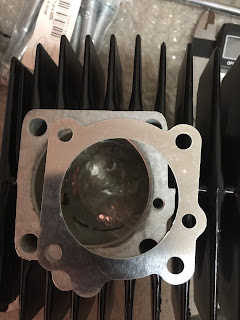Some random pictures and thoughts as I rebuild the motor with the shredded stator seal.
Even though the "Shocko" cylinder still held good pressure, 160 psi, the Treatland Athena cylinder has better porting.
http://www.treatland.tv/honda-hobbit-70cc-athena-cylinder-kit-p/honda-hobbit-athena-70cc-kit.htm
When I used to race motocross, it used to cost me about $80 for a Wiseco piston and then about $80 for someone to bore the cylinder to match the piston I bought. I found that most places do not bore a straight hole or don't bother to match it to they piston I bought. So The Treatland kit seems like a pretty good deal.
The cylinder, in my opinion, still needs the ports chamferred. I run my finger against the ports and if the ports catch on my skin, I file them at an small round file, just to round the edge of the port by a small amount.
The quality of the porting is not perfect. We can see it in the rear boost ports.
I checked the ring end gap and it was 0.13mm. This is tighter than the 0.15mm spec, so I will pass a flat file across the ends for a few strokes. It won't take anything to knock 0.02mm off. I use a cheap pair of Amazon magnifying glasses, when I work on the chamfering the ports or looking at ring end gap.
Arrow on the piston points to the exhaust port. "N" or numbers or letters on the ring face up to the crown of the piston. There's a single ring on this piston. My history with running a single ring strokes, is they rev faster and make more horsepower, but don't last long. On 1986 TRX250R that I experimented with running a single ring, I ended up needing to changed the ring every two weekends of motocross.
The piston pin that was in the motor looked good, but I could detect ridges, so I am going to use a new piston pin.
The cylinder needs some fins cut if you are going to use the pre 2 speed oil fill bolt in the front of the motor. This is a picture of the Athena cylinder that is currently in my 1981 motor.
I used a right angle dremel tool cut the fins on the cylinder. Not my favorite solution, but it worked.
After cutting the fins and the chamfering, flush the cylinder out with lots of soap and water. Then lubricate the cylinder.
I am going to put an extra base gasket on the cylinder, to raise the cylinder, raise the port timings and lower the compression. When I used the 47.6mm Athena kit on the 1981 engine, I was getting some mild detonation in the mid range. I went to premium gas and this reduced it, but it was always still there. I had the head bolts repeatedly loosen up, so either the detonation or the cylinder pressure was probably lifting the head. I would rather have higher ports and I would like to target about 150 psi compression. This 0.7mm base gasket should give me another 27 thousands of clearance.
Treatland has 47.6mm metal head gaskets.
I am using a 47.6mm Airsal head from Treatland. This does not have a lot of cooling fin area, but through the summer in Atlanta, peak head temperature was 380F on the 1981 motor. This is not a great head temperature, but I can live with it.
The normal head bolts are M6x100 1mm thread flange bolts. These are too long for this head. On the buildup of the 1981 motor, I used Honda 95701-06090-00 M6x90 thread flange bolts:
I would like to use studs instead, but I have not searched around to find them yet. There is a small advantage to using studs in this application. As you are torquing down bolts, there is both a twisting and a tension force applied along the length of the bolt. When you have a stud, the twisting force along the stud is reduced and the torque that you are measuring at the torque wrench is largely the result of the tension force. You get a better torque measurement.
I don't have any M6x90 flange bolts, but I do have some M6x85 flange bolts, so I will try to use those.
I used a Honda Urban Express, NU50, reed cage with Carbon Fiber reeds. It takes a little bit of grinding on the cases to fit them, but they are bigger reeds. I pack the area around the intake before grinding the cases. Then after the grinding I thoroughly flush the lower end with vegetable oil.
I use an Motion Left Moped, MLM VM 20 Intake from Treatland. The VM20, even though it is a big carb, is similar to ones I used in the 80s and 90s and I know how to tune them. To match this up to the NU50 reed cage, I use an NU50 reed spacer and then grind the reed spacer to match the MLM output port. I use paint to imprint on the reed spacer where to grind away.


















